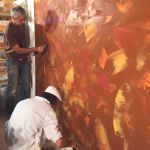The lime plaster workshop "Rendering and harling with lime" in Scotland took place on 3-5 March and was carried out by Scottish Lime Centre Trust. This is an organisation that gives advice and workshops for private customers and for organisations about lime plaster, mortar and paint. They promote the knowledge and traditional skills required for the conservation, repair and maintenance of the historic built environment, be it and A-listed castle or a garden wall.
As Scotland has wet climate and many cold periods where most of the buildings are built of stone, therefore all the lime plasters used inside and outside are based on NHL (Natural Hydraulic Lime). During the three-days practical course was tought how to make a lime plaster from the components, different plastering and finishing techniques (including Scottish traditional facade plastering technique named harling). In addition we made several tests about the suitability of sand and for determining the proprotion of binder and filler in the plaster. On the last workshop day different "good" and "bad" examples were introduced on restored works in Dunfermline. We also visited the ruins of old lime kiln in a village named Limekiln.
Look at the photos in GALLERY!
On the Portugal course "Workshop of decorative lime and earth stuccos" on 22-26 April were practiced different decorative finishes based on lime and clay. The workshop was carried out by local Portuguese company CasaDaCor, who produces and sells natural building materials with brand name Embarro.
On this five-days course were introduced Japanese fine finishing techniques, were practiced Moroccon waterproof technique tadelakt, were tried local clay plaster mixtures and also our new products - Estonian clay paints of four different colours - were introduced. We learnt thoroughly hot to make stucco from base components. Stucco is an exclusive finishing technique that is typical in Portuguese palaces. We learnt all the stucco making process - slaking and sieving lime, mixing different base and finishing layer mixtures and applying them on the surface. We also practcied fresco technique that is making paintings on a fresh lime surface with calcareous pigment water. Of course visiting local work sites and tasting seafood and wine from Algarve area were part of the course days.
You can look at the photos in GALLERY!
This article reflects only the author's view and the NA and the Commission are not responsible for any use that maybe made of the information it contains.


